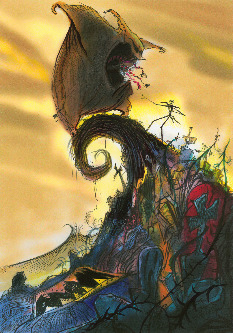Vince Matthews on Digital Disney: An Interview with Deane Taylor
Page 3 of 4

LP: What was the biggest technical challenge you faced with the game and how did you overcome that?
DT: The biggest challenge for me was to understanding that a pixel is a unit of measurement and (it) occupies a real space. It's no different to an animator getting their head around the fact that 1/24th of a second is a unit of time. I had to stop myself looking for "real" things. Actually I don't think I’m quite over that.
LP: What was the biggest creative challenge?
DT: I had full and total confidence in everything we did. I knew what felt right because at every step of the design phase I would stand back and look at the way the elements connected, as if through Tim's eyes. The challenge was to show the result to Tim and have him share this confidence. (But) there was no issue of having to justify it - the work spoke for itself.
LP: Did you "update�? the look for the video game audience?
DT: The look, I don't think was necessarily updated as much as expanded upon. I've heard arguments about more sophistication, more exposure to cool things and so on, but fundamentally I don't think (that) audience is any different to any other, though they would probably like to think so.
LP: Describe the style of art and how is it different from other styles in CG films and games?
DT: Gothic Noir. Somewhere between The Grimm brothers, Frankenstein, Gaudi and Dr. Seuss. All things Tim Burton. How it differs to other games is not something I feel qualified to say since my knowledge in this area is so limited. What I would say is that there was a very conscious effort to bring a cinematic feel to the game. Not in the sense of an action blockbuster, but more in the sense of its aesthetics, and its charm. The difference between watching an interesting book unfold before you, compared to a rock clip.
LP: Any personal favorite creations from these Nightmare Before Christmas games?
DT: You know, I couldn't really say. With the movie, I think it took me about six years to decide that I liked Lock Shock and Barrel's tree-house interiors the best., and then recently I decided I liked Town Hall more...It's like opening up a Far Side book, you find a new favorite every time. One thing that is important about the new locations (in the game) is that they all have an actual history, or back-story behind their creation. You won't see this, but you will feel it. In order to design what it is, you need to design why it is.
LP: How was it working with Capcom’s Japanese development team?
DT: To begin with, we were mostly the same height, which is a rare thing for me. I've only ever experienced that once before, when I worked on the Smurf series. More importantly though, was the creative synergy. Here was a crew of highly talented professionals who, for the most part might have been in their early teens when the movie was released. When I met with them, I got an immediate sense that they were honored and privileged to have the opportunity to work on this. It was a classic to them. I could see it in their sketches, and in the things we discussed. I felt completely at home with this group of artists and held them in the highest respect. We had extensive meetings, and more often than not, we were communicating freely without the need for a translator. I was very impressed with them.
LP: Over ten years have past since the release of The Nightmare Before Christmas. Are you surprised that the film had such an impact on people and that it still seems to be finding new audiences?
DT: This is a constant source of surprise to me, but at the same time I can understand it. The film is unique in its feel, and seamlessly directed. In a sea of animated films that differ from each other by such minute increments, it has to stand out.
LP: When you’re working on a video game are you sitting with the development group the whole way, or are you reviewing things as they get done? Can you tell us a little about the timelines and schedules, like how long did you work on the project?
DT: My involvement was over about 12-18 months. A lot of the work was generated which I made a pass over before it hit the build stage. This was done from South Australia, mostly in my favorite coffee lounge. All work was coordinated through Buena Vista Games in Los Angeles to Capcom in Japan (and then) passing (the work) in front of Tim in London at the appropriate times. We then got into a ping pong match of sketches, plans, color and lighting that continued at distance until we felt we had the framework for completion.
I (then) went to Japan and worked directly with the crew for a brief period. Throughout this, we conducted regular reviews, approvals and development. Despite the enormity of the task, and the production demands on Capcom, the big advantage was that everybody was on the same page. This was a well oiled machine who knew not only what they had to do, but how to help each other achieve the result. That is the only way long distance production can work. And it did.
